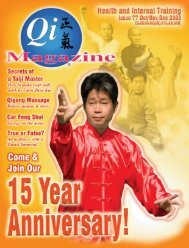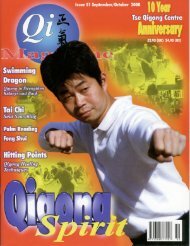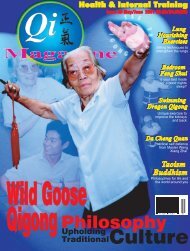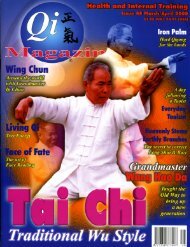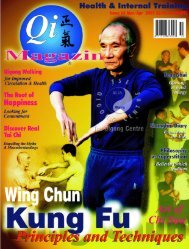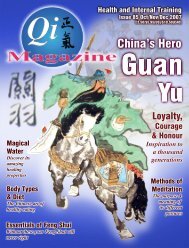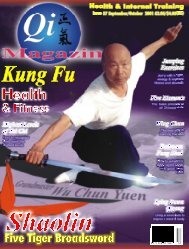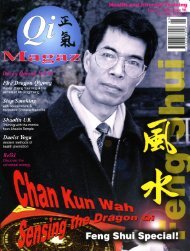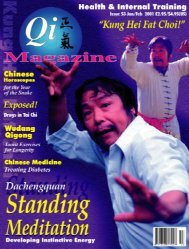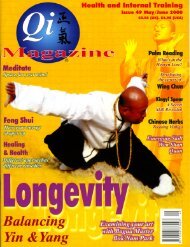Issue 65 - Tse Qigong Centre
Issue 65 - Tse Qigong Centre
Issue 65 - Tse Qigong Centre
- No tags were found...
Create successful ePaper yourself
Turn your PDF publications into a flip-book with our unique Google optimized e-Paper software.
The more that you look at the detail of a sword’s construction the moreis revealed about its uses. Basically, a sword is made of two components, theblade and the hilt, but these can be divided into a number of elements.Swords - Part 2Chen TaijiquanAblade has three basic elements:the blade, the shoulder and thetang (or tongue). A hilt is madefrom a guard, handle, pommel andusually some nuts, bolts or rivets.The pommel is a metal shape atthe end of the hilt. It has severalfunctions. Firstly, it helps hold the handlein place. Secondly, it is normally a littlewider than the handle and so helpsprevent the sword slipping out of thehand. Thirdly and most importantly it actsas a counterweight to the blade. Withoutthe pommel most swords would be veryunbalanced and difficult to wield.The pommel is normally heldon by a nut thats c r e w sd i r e c t l yonto the tang.The handle isthe area that is held bythe hand. This is usually madeout of wood, which helps absorb theshock of impact, but it can also be madeof bone or antler. Sometimes the handlemight be covered with leather or cord.The important thing about the handle isthat it should be comfortable, easy tohold and fix firmly to the rest of thesword. If it is covered, the covering shouldbe firmly fitted so as not to come looseduring use. In Chinese swords you oftenfind a second nut and washer that fitsinside the pommel, which is used tomake sure that the handle is held firmlyin place. Handles come in a variety ofshapes. Lengthwise they can be convex,concave, straight or tapered. It is mostlya question of personal taste and comfort.In cross section the handle of Chineseswords tends to be elliptical. This is sothat the angle of the blade can becontrolled when cutting or parrying. Bycomparison, Western fencing swordshave round handles because they haveno blade and are not usedfor cutting. They arepurely a thrustingweapon.“Fencing swordshave no blade andare not used forcutting”The guard fits between the handleand the shoulder of the blade. It has twobasic functions: it stops the hand slippingonto the blade and it protects the handfrom being cut. On Chinese straightswords the guard is often quitedecorative, but functionally it is little morethan a small cross guard. The small sizeof the guard tells us that a full range ofmovement is essential in Chineseswordsmanship. Larger and morecomplex guards offer more protection(and can be used to strike with) butrestrict movement. Other commonelements to the straight sword guard areecussons that help lock the blade intothe sheath and a chappe, which fits overthe top of the sheath and so helps toprevent rain or moisture getting into thescabard and damaging the blade. TheChinese broadsword usually has an ovaldisk as a guard. Sometimes this is slightlycupped towards the blade which helpskeep the guard rigid as well as partlyacting as a chappe. The oval shape ofthe guard gives protection to the knucklesbut prevents fingering.Fingering is a technique thatinvolves either looping the forefinger overthe guard or pointing along the blade.This technique can make thrusting andstabbing more accurate but it has obviousrisks.The tang is the unedged portionof the blade that runs through thehandle. It is usually narrower than theblade itself and the area that juts outwhere it meets the blade is known asthe shoulder. The shoulder usuallysupports theguard. Ac o r r e c t l yproportionedtang ise s s e n t i a lbecause ithas to beable towithstand ane n o r m o u samount oftorque andstress whenthe sword is just being swung. If it is notstrong enough the handle will simplysnap off when a sword hits somethinghard. The tang will normally tapertowards the pommel and is normallywrought from the same piece of metalas the blade (though sometimes they arewelded on). The tang will also usuallyhave a softer temper than the rest ofthe blade so that it can absorb shock andvibrationto be continued... by Glenn Gossling.glenn@qimagaz ine.compage 10 Qi Magazine Jan/Feb 2003



